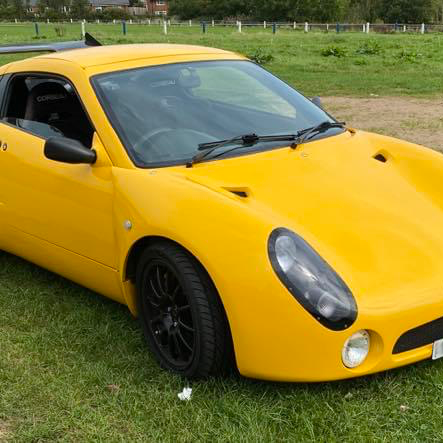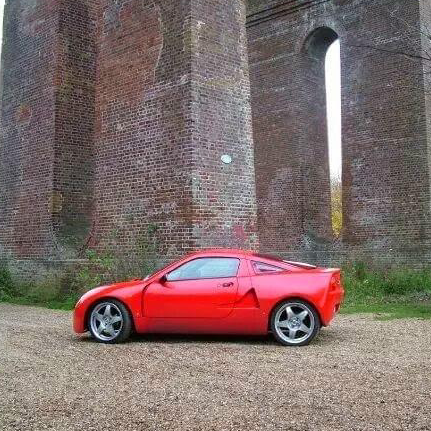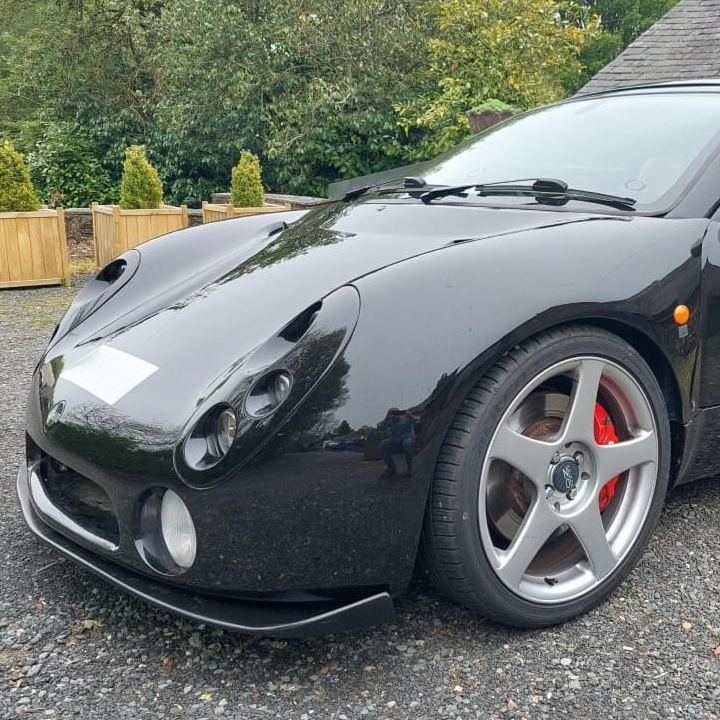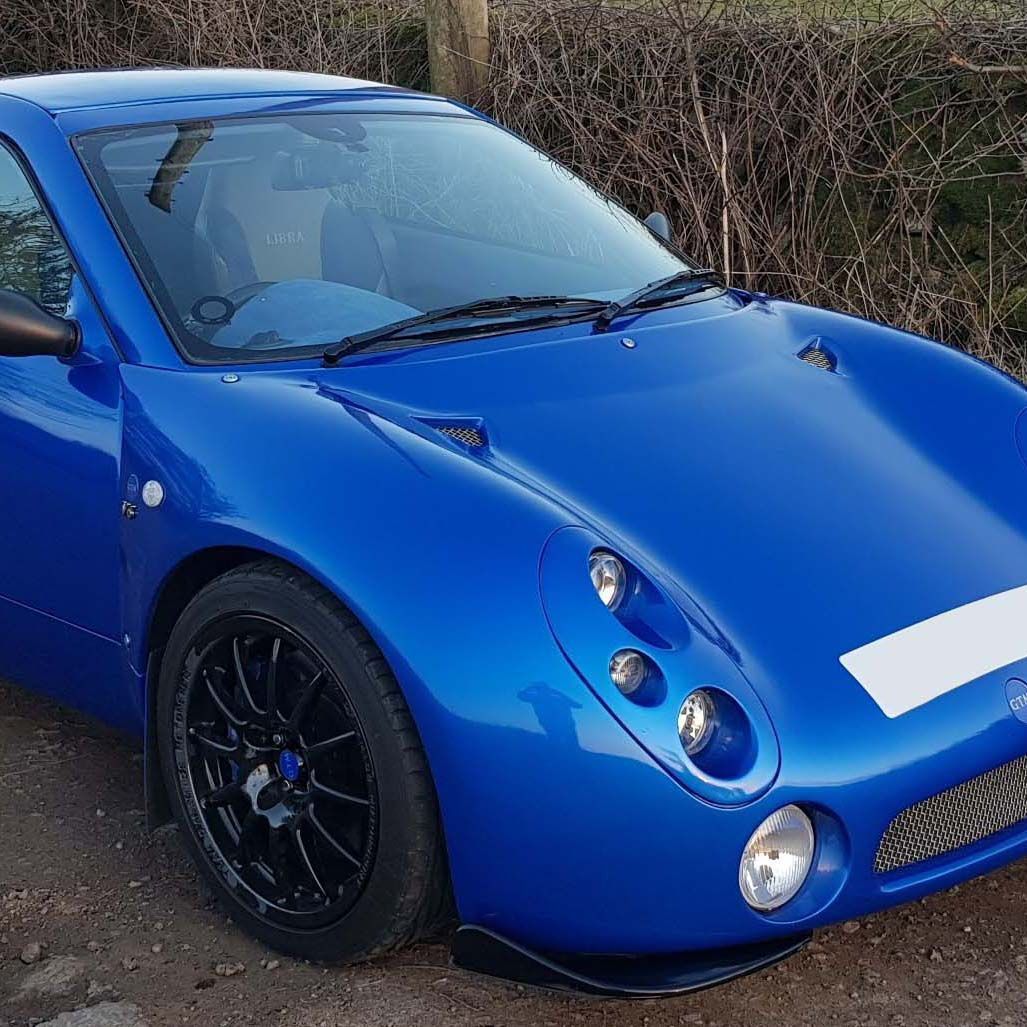History of the GTM
From the original concept up to the last model created
"The GTM marque was launched in 1967"
The GTM marque was launched in 1967 when Cheshire garage owner Bernard Cox and friend Jack Hosker created the Cox GTM (Grand Touring Mini).
The Cox GTM design composed of two Mini front subframes linked by a sheet steel semi-monocoque chassis.
The chassis' deep centre tunnel backbone was supplemented by two generous sills.
The car was mid-engined, the rear subframe contained the engine as in a Mini with the steering arms locked in position with adjustable rods and ball joints.
The front subframe carried the steering rack, fuel tank and radiator. Suspension, brakes and 10 inch wheels remained as per the Mini.
The fibreglass bodywork contained more than a hint of Ferrari Dino in its styling.
The Cox GTM's unveiling at the January 1967 Racing Car Show created great interest and a small band ofstaff began to assemble kits as fast as they could in Bernard Cox's garage in Hazel Grove.
The production of the bodies and chassis was subcontracted out, with the Cox garage bolting and bonding the steel chassis to the body, as well as fitting the doors, bonnet, front subframe and specially made laminated windscreen.
This body chassis package was priced at £330. Any modified Mini components were supplied on a part-exchange basis. Cox claimed that a car could be completed for £500 including painting and trimming.
Few builders actually achieved this!
Performance depended upon the BMC A-Series engine fitted
(848cc - 1275cc) but as the car only weighed around 533kgs even smaller engined cars were impressive.
The prototype Cox GTM had a Cooper S 1293cc engine giving (in its day)
exceptional performance:
0 - 60mph in 6.4 secs
0 - 90mph in 11.8 secs
and a top speed of 115mph.
"Heerey raced a specially built lightweight GTM racer."
Heerey raced a specially built lightweight GTM racer.
Howard Heerey, who had helped Jack Hosker with the styling of the car, raced the road registered prototype during the 1967 season.
Achieving several class placings. for the 1968 season, Heerey raced a specially built lightweight GTM racer.

"Production Problems Limited Output."
Production problems limited output. Despite strong demand for the car, production problems limited output to about one kit per fortnight.
This disrupted Cox's day to day garage business and by autumn 1968, Bernard Cox decided to cease production.
It is believed that just over fifty kits had been produced by the Cox garage.
"Howard Heerey knew the car's potential"
Howard Heerey knew the car's potential having raced the Cox GTM the young Howard Heerey knew the car's potential. In February 1969 Howard and his father (who ran the Midland Garage, located only a 100 yards from the Cox Garage) took over the project.
The car was renamed the GTM.
The Heerey's decided not to use subcontractors, so all moulds and chassis jigs were moved to the Midland Garage. Examining the moulds and jigs soon revealed the cause of the car's production problems. To remedy this, new production jigs were made to ease chassis construction, welding processes were improved to eliminate chassis distortion. The various moulds were either renovated or replaced and several components were redesigned.
The results of all this work were improved appearance and easier assembly. Heerey continued to improve the design and in early 1971, after some 170 cars had been built by the company (now known as Howard Heerey Engineering Ltd) the Heerey GTM 1-3 was announced.
The Heerey GTM 1-3 (model 1, variation 3) had been restyled with a new lower nose incorporating the Mini bumper and a new rear panel to make use of Triumph Dolomite rear lights. Under the skin, the chassis has been made lighter and easier to make by fitting a space frame structure instead of the sheet steel assembly which held the rear subframe.
The space saved also allowed the radiator to be fitted alongside the engine as in a Mini.. This saved having pipework running the full length of the car, and resulted in underfloor air ducts and a side vent being incorporated in the design. The Heerey GTM bore a strong resemblance to the modern GTM available today.
Despite all this development work and strong sales, disaster struck the company in March 1972 when a compulsory purchase order by the local council for a road widening scheme forced the company to fold. Around 70 Heerey GTMs had been built.
In June 1972, a Hartlepool fibreglass company bought the demonstrator car, moulds, jigs and spares. The company never produced a single car and in 1976 KMB Autosports bought the GTM project.
KMB, headed by Mike Smith, started supplying spares for existing cars but never made any new cars. Around this time, Peter Beck, the owner of a Heerey GTM, came across KMB Autosports and tried to order spares from them to keep his car on the road. Peter had (like many people with an interest in cars) dreamt of designing his own car.
Events at Peter's workplace forced him to look for alternative employment and led him into discussions with a struggling KMB. In 1980 Peter, his friend Paddy Fitch and another partner, Dougal Cowper, became the new owners of the GTM marque.

"Dougal left the venture 8 months after GTM Cars set up in a small Nottingham factory unit."
Dougal left the venture 8 months after GTM Cars set up in a small Nottingham factory unit. 1980 was acritical year for the fledgling company, managing to sell sixteen kits despite the poor state of the original Coxbody moulds.
Peter and Paddy knew that to escape the problems of the previous companies, a lot of work needed to be done to the car. The next few years were a steep learning curve for the pair. New moulds were a top priority and were soon developed into the current shape.
The new moulds were designed to accomodate13 inch wheels as well as other minor modifications and were of such high quality that for the first time, the car could be offered in gelcoat finish.
The chassis also came in for attention, with the steering rack relocated to cure the bump steer that had afflicted the earlier cars. Glass, rather than perspex side windows were now fitted and a front mounted Allegro radiator cured over heating problems.
These and other structural improvements, increased the weight to 610 kgs but resulted in a stronger car with almost perfect weight distribution.
The company moved to the Sutton Bonnington site in 1982 and the revised car in the form we know it today, was finally ready in 1983.
With the GTM Coupe, as it was now known, finally sorted and bringing in orders. Peter and Paddy turned their attention to designing a new model. The new car was to be a convertable, based on the same design concepts as the Coupe.
A professional stylist, Richards Oakes, was brought in to help with the design. The original idea of using a steel chassis like the Coupe was abandoned in favour of an all fibreglass monocoque. The moulding used bonded in marine plywood sill and rear bulkheads and the fibreglass itself was between1/4 and 1/2 inch thick, depending on location. The company moved to the Sutton Bonnington site in 1982 and the revised car in the form we know it today, was finally ready in 1983.
With the GTM Coupe, as it was now known, finally sorted and bringing in orders. Peter and Paddy turned their attention to designing a new model. The new car was to be a convertable, based on the same design concepts as the Coupe.
A professional stylist, Richards Oakes, was brought in to help with the design. The original idea of using a steel chassis like the Coupe was abandoned in favour of an all fibreglass monocoque. The moulding used bonded in marine plywood sill and rear bulkheads and the fibreglass itself was between1/4 and 1/2 inch thick, depending on location.
The curved body shape added further stiffness essential for an open top vehicle. Bolt on front and rear sections provided crumple zones that could be easily repaired or replaced in the event of an accident.
Like the Coupe, the body was in gelcoat finish to remove the expense of painting.
A fibreglass hardtop provided the droptop with year round practicality.
Mechanically, the car used the same two Mini front subframe concept as the Coupe. After four years of development, the GTM Rossa was launched at the 1986 Stoneleigh Show.

"The kitcar industry is forever moving forwards"
The kitcar industry is forever moving forwards so to keep ahead of the competition, the Mk2 Rossa was unveiled in 1989. The Mk2 kept the same mechanics as the Mk1 Rossa, but featured restyled front and rear sections. The new mouldings could also be fitted to Mk1 cars if desired.
Other events occurred in 1989 which would involve GTM in the near future. Midas Cars Ltd, a well regarded competitor of the GTM cars, was devastated by a factory fire and was forced to cease trading.
Fortunately, the moulds had survived and were bought by Pastiche Cars Ltd. The Midas Bronze (Mini based), Gold and Gold Convertable (both Austin Metro based and designed by Richard Oakes) were fibreglass monocoque designs making use of the donor vehicles front and rear subframes.
They joined the existing NG range of1930s inspired roadsters at the Pastiche factory in Rotherham.
Sadly, this did not last long as on the 11th ofJanuary 1991 Pastiche Cars Ltd went into receivership.
In March 1991, GTM bought the moulds and jigs of the entire Pastiche range. In theory, GTM now had eight different models in its range!
Sensibly, GTM sold many of the projects on to other companies.
The Midas Bronze became the Midtec Bronze, while the NG range was sold to a new company, NG Cars Ltd.
GTM began selling the Midas Gold Convertable alongside its existing models while the Gold Coupe disappeared from sight. If GTM had a weakness, it was the fact that all of their models used the aging A-series engine.
While being perfectly suitable for most owners needs, some felt that it was letting the GTM cars down compared to the powerplants used in some other cars.
Around this time, Rover had just launched their new Metro, powered by the new aluminium K-Series engines. Rumours also persisted that Mini production would cease. Once again, Peter and Paddy sat down at the drawing board to come up with a new design.

Together with Richard Oakes, GTM took the existing Mk2 Rossa concept and styling and married it with the running gear of the new Rover Metro. Two Metro front subframes were bolted to the front and rear of a very rigid fibreglass monocoque. A K-Series engine and 5 speed gearbox were mounted in the rear subframe. Although strongly resembling the Mk2 Rossa, the body work was in fact all new. The front and rear crumple zone mouldings were replaced by one piece bonnet and engine cover mouldings similar in concept to the Coupe. The Rossa K3, as it became known, went on sale in the summer of 1993. Predictably, customer interest in the Mk2 Rossa switched to the new K3 and the Mk2 soon dropped off the factory price list.
"The Libra was a coupe with a removable roof section"
The Libra was a coupe with a removable roof section the success of the K-Series engined Rossa K3 fueled developments at the Sutton Bonnington factory and in1995, GTM released the Midas Coupe.
Once again enlisting the services of Richard Oakes, this all new fibreglass monocoque made use of the Rover Metros front and rear subframes, along with its K-Series power plant, suspension, steering rack and column, wheels and many other items, making it a true single donor car.
1995 also saw the original GTM Coupe project being sold to Peter Leslie, an existing Coupe owner. The Coupe would from now on be known as the Primo Designs Coupe. GTM Cars Ltd would still produce the mouldings for Primo.
No sooner was the Midas Coupe finished, Peter and Paddy began work on yet another new design. Launched in 1998, the GTM Libra is a more upmarket sports model with fewer compromises than the earlier cars.
Richard Oakes was again called in to help come up with a design which would rival the likes of the Lotus Elise and Caterham 21, let alone other kitcars.
The Libra was a coupe with a removable roof section (to maintain chassis stiffness) using a fibreglass monocoque.
The monocoque has over 20 box sections in its design giving a very rigid structure (The Lotus Elise has a torsional stiffness of around 10,000 Nm per degree while the Libra has been tested as 14,000 Nm per degree).
Although it uses the Rover Metro as a donor, the Libra does not use Metro subfames. At the front, Metro hubs are mounted on fabricated double wishbones and coil-over dampers bolted to the monocoque.At the rear, fabricated trailing wishbones and coil-over dampers are fitted (in a similar manner to the Renault Spyder).
The K-Series engine and gear box are mounted to a triangulated tubular steel frame. In addition to the 1.4 Metro engine, the larger 1.6 and 1.8K-Series units can be fitted.
The Metro donor also supplies the fuel tank, radiator, brakes, wipers, electrics and miscellaneous small components.
The Libra was designed to be much easier to assemble than the previous cars and it is no coincidence that the factory offers fully built Libras alongside the kits.
















